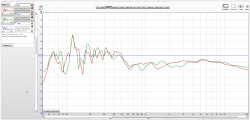I so agree. I think I fell in this trap and forget to trust my ears. Dirac is special but I let it go out of my system and now I tried to work with 2 to 5 filters for each channel and want to reducate my ears!
and I do think Dirac is special, I just think most people don't understand how it works and as such attempt to replicate it based solely on measurements. Basically, DIRAC can't be replicated by the average user, and IIR filters found in consumer products cannot do what it does, even with the right correction calculations.
2-5 bands sounds reasonable. I really do think that EQ should be focused mostly below around 100-150hz or so. That above this point, up to say 300-500hz you can get away with a little EQ. For example, there is a difference in the tonal balance between my mains and surrounds, it extends up to about 500hz, where there is a broad and pronounced bump in the midbass response. I have removed that via EQ. I think that is ok. It shows up in all measurements, it's of low Q, etc.
In any case, a flat response is not our goal. the only way to achieve a flat measured response in a room from any single measurement is via an anechoic chamber and a speaker with a perfectly flat response at all radiation angles. Our listening rooms should not be anechoic chambers, those reflections are critical to our perception of realism. Further, no speaker has such a good response.
It is amazing how our hearing becomes accustomed to certain sounds. I don't think that is so bad, I hear people talk about trying to flatten their response to make it more neutral and accurate. As we've already discussed, that is a pretty abstract comment. Accurate in what way? First, we know that a flat response doesn't actually mean a flat response, so we very well may have already made things less accurate. But, we also have no idea what the real event is supposed to sound like. There are no standards for studio sound, so we have no idea what the artist intended. Sure we may have heard the same recording performed live, but who says that is what the artist intended the album to sound like? I've attended some atrocious sounding concerts. When it comes to modern music, where the "real event" or "absolute sound" is some abstract concept we can never really "know," I say go with your ears. Whatever sounds right is probably as good as any answer. The exception to this is live acoustic music, especially symphonic performances. In this case, the recordings are done of the event itself, there is a real event and we can know it. I want my system to perform both of these well, but because of the "circle of confusion" with studio sound, a system that is accurate to a real live event recording is not necessarily more accurate of a studio recording.
I can certainly point to some concerts or musical experiences where the "bar was raised" for what the real event is supposed to sound like. In general, I find the most significant issue being dynamics, few systems are capabpe of accurately capturing the dynamic scale of a live event. They often fall just too far from reality. My current system is the closest I've ever been, but it still doesn't like like a real live symphony.




















